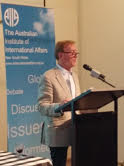Has traditional art survived the economic transformation of China?
On 31 March Edmund Capon, former director of the Art Gallery of NSW, addressed a lively audience at Glover Cottages on transformations in China. He recalled that in living memory everyone had worn the same clothes and ridden bicycles. Since then a vast and relentless march of materialism had transformed the physical and social landscape. Had this new wealth attenuated artistic traditions? According to Edmund, no. China’s indelible cultural instincts were still there, including the timeless value invested in the three perfections of painting, poetry and calligraphy. In a poem he wrote on the Long March, Mao had demonstrated his mastery of calligraphy, even if in a politically correct manner. Recently, modern artists like Ai Wei Wei were emerging who were themselves masters of social commentary and political subterfuge. Ai Wei Wei’s recent exhibition of ancient pots covered in a bright synthetic modern glazes underlined his delight in paradoxes like the value of valuelessness. Chinese contemporary art was forceful and gregarious, an expression of pent-up frustration. Yet Ai Wei Wei, like most of his contemporaries, was umbilically attached to China’s cultural heritage. And it was possible to discern a new trend: contemporary Chinese art was becoming less prescriptive than before, and vastly more practitioners were involved. Meanwhile, cultural sites around the country were hugely patronised and energetic efforts have recently been taken to preserve them. There was an efflorescence of private art galleries and museums, and China’s new-found wealth was having an extraordinary impact on China’s place in international markets. Edmund observed that Chinese art has never existed for its own sake – it has always had practical reasons. Today, tourism was increasingly one of them. Yet, he concluded, in spite of its materialistic progress, China’s cultural sensitivities and its collective veneration for its artistic traditions remained firmly intact.
Notes prepared by Richard Broinowski
